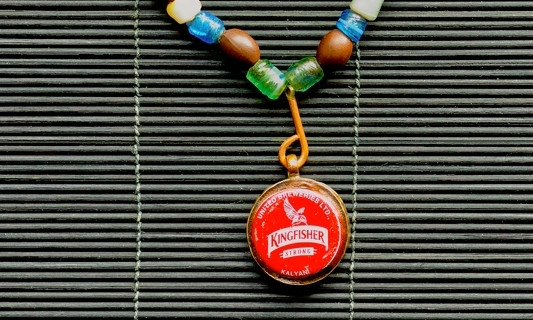
Amman Rashid necklace (2011) Kingfisher beer bottle cap, lotus seed beads, glass beads, copper wire, cotton thread and carnelian agate, approx 14 inches, photo: Anil Advani
This is an update to an article that I wrote for Art Jewelry Forum The DIT (Do It Themselves) Movement In Indian Contemporary Jewelry. In it I mentioned the work of the Bangladesh jeweller, Amman Rashid:
The Bangladeshi jeweler Amman Rashid would seem a more conventional candidate for contemporary jewelry. He sources materials from a broad range of cultural sources, including ink pots, trade beads, hookah parts, old brass seals, old cutlery, and old broken pottery pieces. Each work is unique and has its own name, such as Chiroshokha, Krishnobott, Kanchon, Protnotattik, and Aadibashi. There is no gallery for his work, and he has never heard of contemporary jewelry. He frames the work himself under the concept Aadi, which means “beginning” in Sanskrit. His work fits the studio model, and he is keen for international exposure. Can we imagine a Bangladeshi in Munich?
Above is an image of his work that is missing from the article.
Since then, I’ve also heard from the Indian jeweller Eina Ahluwalia, who I wrote about in a previous AJF article. She gives a little more background to her workshop conditions. She has three teams of artisans who have their own workshops and work on contract. There are occasions when the teams introduce their own ideas into the design process. The way she operates, the price is fixed by the craftsperson. For Eina, is it important that their interests are served for the long term survival of skills:
It is imperative that we make the trade monetarily worthwhile for the artisans to keep the craftsmanship alive. We need to compensate them for their unbelievable skills, their patience, perseverance and enable them to live the lives they wish for themselves and their families, or else they will leave the trade.
Let’s hope we see more of the work by jewellers like Eina and Amman in the future. They have much to give to the contemporary jewellery field.
